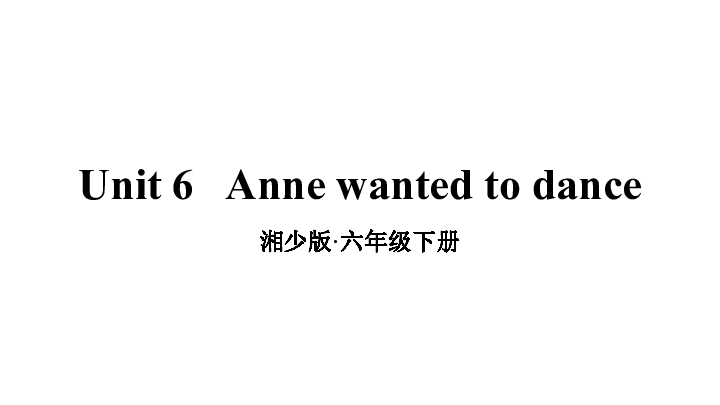(
课件网) Unit 6 Anne wanted to dance 湘少版·六年级下册 Lead-in What did you want to do? I wanted to dance. What did he want to do? He wanted to sing. What did she want to do? She wanted to sleep. New words 移动 容易的 踩 大声地 钢琴 Let’s listen and say Lingling was dancing in the dancing room. Anne watched her. Anne wanted to dance like Lingling. “ Wow! Lingling! You can dance very well,” said Anne. “ Can you teach me? ” “ Ok, Anne. I move my hands and legs with the music,” said Lingling. “ Now, put your arms out like this. Listen to the music and move your legs with the music. It’s easy and fun,” said Lingling. Anne went to the dance floor and danced with Lingling. She stepped on Lingling’s foot. “I’m sorry,” said Anne. “It’s OK. Let’s do it again,” smiled Lingling. Language points Lingling was dancing in the dancing room. 玲玲在舞蹈室跳舞。 过去进行时表示在过去某一时刻或某一段时间正在进行或发生的动作。 根据主语选择was或were。 例句:昨天下午四点钟我们正在上课。 We were having class at 4:00 p.m. yesterday. 2. Anne wanted to dance like Lingling. 安妮想要像玲玲一样跳舞。 want 作动词,意思是“想要,需要”。 want to do sth 想要做某事 拓展:want sth. 想要某物 want sb to do sth 想要某人做某事 例句:我想要一个苹果。 I want an apple. 3.You can dance very well. 你跳得真好。 注意:good和well都可以翻译成“好”,但是 good是形容词,常修饰名词;well是副 词,常修饰动词。 例句:他钢琴弹得很好。 He can play the piano well. 此句中well是副词, 用来修饰动词dance。 4. Can you teach me? 你能教我吗? teach是动词,意为“教;讲授”。 teach sb表示“教某人”。 例句:王老师教我们英语。 Mrs. Wang teaches us English. 拓展:teach sb. sth. 教某人某东西 teach sb how to do sth 教某人怎样做某事 注意:teach sb sth所构成的双宾语结构中, sb要用宾格形式。 5. I move my hands and legs with the music. 我随着音乐移动我的手和腿。 拓展:with sb 和……某人一起 with 使用…… with是介词,本句中是“随着……”的意思。 6. It’s OK.没关系。 Never mind. 别在意。 It doesn’t matter. 没事的。 That’s all right. 没关系。 其他表示“没关系”的短语: 7. Let’s do it again. 让我们再做一次。 Let’s开头的祈使句, 常用来提出某种建议或号召其他人一起做某事。 例句:让我们去散步吧。 Let’s take a walk. 注意:Let’s后面接动词原形。 Let’s Learn stand on one foot read a story aloud 单脚站立 大声朗读故事 paint a picture 画画 play the piano 弹钢琴 Language points 辨析:aloud, loud 和 loudly 相同点:都可以表示“大声地”。 不同点: aloud与read,think连用时,表示“出声”,而loud用于talk,speak,shout,laugh等动词之后,在口语中代替loudly。loudly 放在动词前后均可,含有“喧闹”或“嘈杂”的意味。 辨析:paint和draw 相同点:都有“画画”的意思。 不同点: paint 指用颜料作画,如油画、水彩画、或者水墨画; draw 通常指用铅笔、钢笔或者粉笔描绘轮廓或线条,一般不涂上颜料。 “play+球类名词”中间不带the; “play+乐器”中间须带the。 如:play basketball 打篮球 play the piano 弹钢琴 Let’s Practise Name What did he/she want to do? Lingling She wanted to sing and d ... ...

